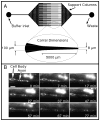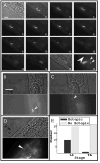Single-synapse ablation and long-term imaging in live C. elegans
- PMID: 18579213
- PMCID: PMC2535809
- DOI: 10.1016/j.jneumeth.2008.05.007
Single-synapse ablation and long-term imaging in live C. elegans
Abstract
Synapses are individually operated, computational units for neural communication. To manipulate physically individual synapses in a living organism, we have developed a laser ablation technique for removing single synapses in live neurons in C. elegans that operates without apparent damage to the axon. As a complementary technique, we applied microfluidic immobilization of C. elegans to facilitate long-term fluorescence imaging and observation of neuronal development. With this technique, we directly demonstrated the existence of competition between developing synapses in the HSNL motor neuron.
Figures




References
-
- Ding M, Chao D, Wang G, Shen K. Spatial Regulation of an E3 Ubiquitin Ligase Directs Selective Synapse Elimination. Science. 2007;317:947–51. - PubMed
-
- Duffy DC, McDonald JC, Schueller OJA, Whitesides GM. Rapid Prototyping of Microfluidic Systems in Poly(dimethylsiloxane) Anal Chem. 1998;70:4974–84. - PubMed
-
- Engert F, Bonhoeffer T. Synapse specificity of long-term potentiation breaks down at short distances. Nature. 1997;388:279–84. - PubMed
Publication types
MeSH terms
Grants and funding
LinkOut - more resources
Full Text Sources
Medical
Research Materials

